
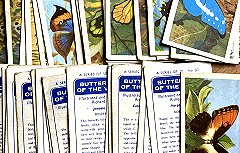

|
 |
|
| Before
we get going I just want to mention something that I have come across, that
may possibly be of minor interest to you, which is that while the terms
'collectable' and 'collectible' are very similar and often used interchangeably,
the nuances in meaning between the two is worth noting in passing. 'Collectable'
with an 'a' typically connotes objects with a particular appeal to collectors
due to factors such as rarity or value, possibly increasing in worth over
time. 'Collectible' with an 'i' is, on the other hand, more inclusive
and refers to any items that people might gather, regardless of rarity or
historic value. Understanding the subtleties between these terms allows
for more precise communication among enthusiasts and collectors of various
items. Just saying. Anyway.............a bit of history, a bit of information, a bit of passing interest and lots of pictures - see how many of these you remember, or even collected. Trading cards, or 'tea' cards as they are more widely known, probably evolved from the popularity of cigarette cards which, in the mid-19th century, were sets of collectible trading cards inserted into cigarette packs to stiffen the packaging and promote brand loyalty. They featured sets of subject-related cards including themes such as famous people, sports stars, cars, wildlife and historical events. With paper shortages increasing during and after World War II, and improvements to packaging, the inclusion of cards became less desirable to the manufacturers. As the shortage receded, the marketing advantages of including collectible cards with products again became apparent and many unrelated products that relied on 'repeat' sales started to include them in their packaging. Now, by creating colourful, collectible sets of cards on subjects like aircraft, dinosaurs and a wide variety of animals and plants, they had the added advantage of encouraging young people and children to influence parents' purchasing decisions for products that they were never intended to be a target for. The vagaries of luck and the satisfaction of finding a rare or sought-after card added an element of anticipation and excitement to the hobby despite the frequent frustrations of duplicates or hard to get 'rare' cards. The practice of swapping cards with, or acquiring cards from, relatives, neighbouring friends or kids at school added a social element to collecting that has since given them a sentimental value tied to childhood memories even though the monetary value is comparatively small except in a very few cases where rarity or condition can vastly increase their value. Possibly less so today, except for card-based games, various football-based issues and strangely 'cult' things like Pokemon, but card collecting was quite a big thing up to, and including, the Sixties and there can't be many of us who didn't pursue the 'holy grail' of owning complete card sets! As the practice of putting cards into cigarette packets had dropped dramatically and pretty well ended in the Sixties after the 1962 Royal College of Physician's recommendation for the limitation of tobacco product advertisement, so we'll just consider the following types of card as we meander through some information on this page concerning what is quite a huge and complex subject. Tea cards, Bubble Gum and Confectionery cards plus some unusual miscellaneous items. |
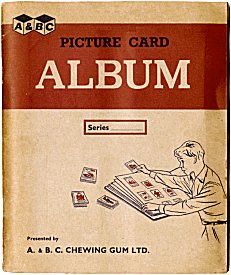 |
 |
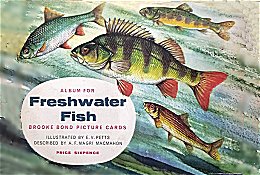 |
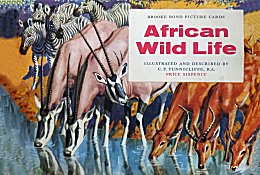 |
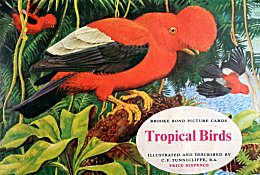 |
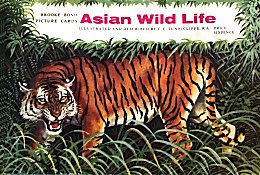 |
 |
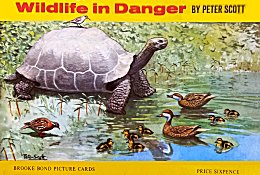 |
|
1960 Freshwater Fish (Brooke Bond 50 cards) Illustrated by E.V.Petts Described by A.F. Magri Macmahon |
1961 African Wild Life (Brooke Bond 50 cards) Illustrated and described by C.F. Tunnicliffe, R.A. |
1961 Tropical Birds (Brooke Bond 50 cards) Illustrated and described by C.F. Tunnicliffe, R.A. |
1962 Asian Wild Life (Brooke Bond 50 cards) Illustrated and described by C.F. Tunnicliffe, R.A. |
1963 British Butterflies (Brooke Bond 50 cards) Illustrated and described by Richard Ward |
1963 Wildlife in Danger (Brooke Bond 50 cards) by Peter Scott |
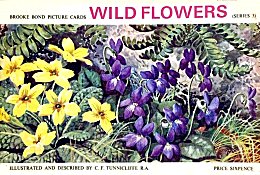 |
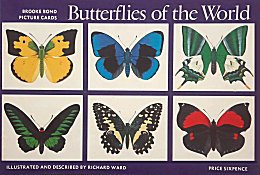 |
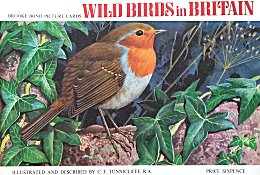 |
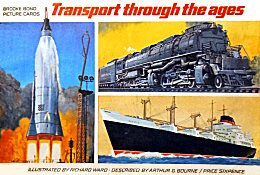 |
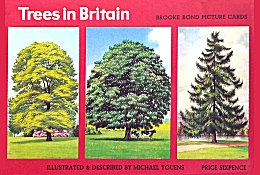 |
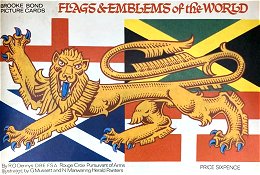 |
|
Wild Flowers (series 3) (Brooke Bond 50 cards) Illustrated and described by C.F. Tunnicliffe, R.A. |
1964 Butterflies of the World (Brooke Bond 50 cards) Illustrated and described by Richard Ward |
1965 Wild Birds in Britain (Brooke Bond 50 cards) Illustrated and described by C.F. Tunnicliffe, R.A. |
1966 Transport through the ages (Brooke Bond 50 cards) Illustrated by Richard Ward Described by Arthur G.Bourne |
1966 Trees in Britain (Brooke Bond 50 cards) Illustrated and described by Michael Youens |
1967 Flags & Emblems of the World (Brooke Bond 50 cards) Described by R.O.Dennys O.B.E., F.S.A Illustrated by G.Mussett and N.Manwaring |
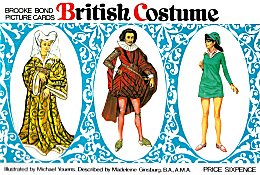 |
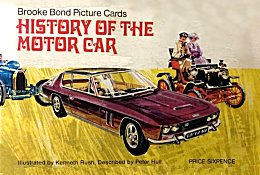 |
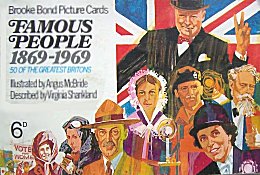 |
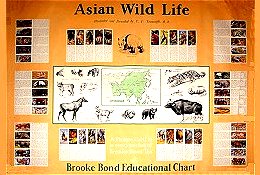 |
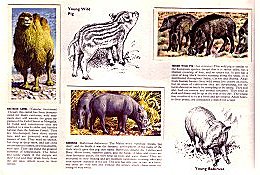 |
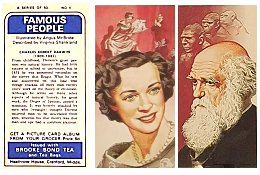 |
|
1967 British Costume (Brooke Bond 50 cards) Illustrated by Michael Youens Described by Madeleine Ginsburg B.A. |
1968 History Of The Motor Car (Brooke Bond 50 cards) Illustrated by Kenneth Rush Described by Peter Hull |
1969 Famous People 1869 - 1969 (Brooke Bond 50 cards) Illustrated by Angus McBride Described by Virginia Shankland |
1962 Asian Wild Life One of the wall charts produced by Brooke Bond to help with education in schools |
1962 Asian Wild Life The text on the back of the card was reproduced inside, as well as additional information and illustrations not on the cards |
1969 Famous People 1869 - 1969 In most cases the images were high quality illustrations with actual photographs only being used in much later series |
|
1954
|
20 cards | British Birds |
1974
|
50 cards | The Sea - Our Other World |
1985
|
20x Double 40 cards | Incredible Creatures |
1994
|
12x Double 24 cards | Creatures of Legend |
|
1955
|
50 cards | Wild Flowers Series 1 |
1975
|
50 cards | Inventors and Inventions |
1986
|
12 cards | Chimp Stickers |
1994
|
20x Double 40 cards | Going Wild |
|
1956
|
50 cards | Out Into Space |
1975
|
50 cards | Wonders of Wildlife |
1987
|
20x Double 40 cards | Unexplained Mysteries of the World |
1995
|
50 cards | The Secret Diary of Kevin Tipps |
|
1957
|
50 cards | Bird Portraits |
1976
|
40 cards | Play Better Soccer |
1988
|
12 cards | The Language of Tea |
1996
|
40 cards | 40 years of Chimps television advertising |
|
1958
|
50 cards | British Wild Life |
1977
|
40 cards | Police File |
1988
|
25x Double 50 cards | Discovering Our Coast |
1997
|
45 cards | Pyramid Power |
|
1959
|
50 cards | Wild Flowers Series 2 |
1978
|
40 cards | Vanishing Wildlife |
1989
|
25x Double 50 cards | The Magical World of Disney |
1998
|
30 cards | The Wonderful World of Kevin Tipps |
|
1970
|
50 cards | The Saga of Ships |
1979
|
40 cards | Olympic Greats |
1990
|
25x Double 50 cards | A Journey Downstream |
1998
|
20 cards | International Soccer Stars |
|
1971
|
50 cards | The Race into Space |
1980
|
40 cards | Woodland Wildlife |
1991
|
6x Double 12 cards | Teenage Mutant Hero Turtles - Dimension Xescapade |
1999
|
19 cards | Oracle Cards |
|
1971
|
50 cards | Prehistoric Animals |
1981
|
40 cards | Small Wonders |
1992
|
20x Double 40 cards | Olympic Challenge 1992 |
1999
|
1 card | Survey Card |
|
1972
|
50 cards | History of Aviation |
1983
|
25x Double 50 cards | Queen Elizabeth I - Elizabeth II |
1992
|
20x Double 40 cards | Natural Neighbours |
1999
|
1 card | Thank You Card |
|
1973
|
50 cards | Adventurers and Explorers |
1984
|
25x Double 50 cards | Features of the World |
1993
|
10x Double 20 cards | The Dinosaur Trail |
1999
|
3 cards | Farewell to PG Tips |
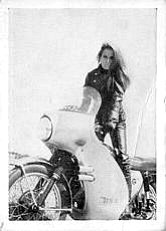 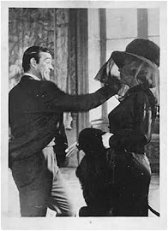 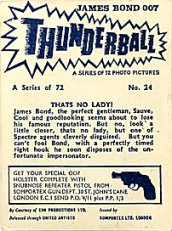 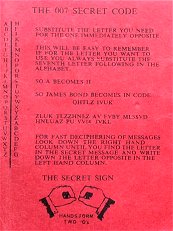 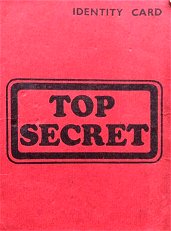 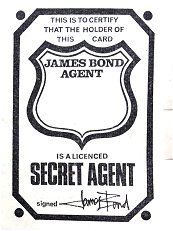 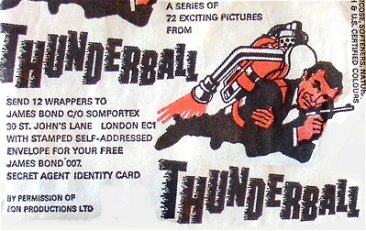 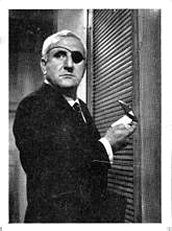 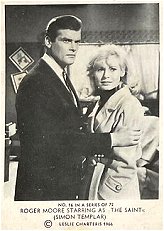 |
|||||||
| Manufactured in 1965 by Somportex Ltd. to tie in with the release of the fourth James Bond movie 'Thunderball', they were made in a small factory in London. This black and white third set of James Bond bubble gum cards contained 72 cards. Each pack contained two cards and a piece of chewing gum. Most of the cards depict stills from the James Bond movie 'Thunderball', except for a few publicity shots of the Aston Martin DB5. The first run of cards were produced early to maximise card sales in shops and cinemas when the film was released but was issued without some later film scenes as these weren’t available at the time of printing. The second run replaced some cards with newly available underwater scenes so, although still marked as a 72 card set, there were actually 80 cards including replacements. |
| One notable
set of their cards were World War II-based cards known as ‘Battle Cards’
which they issued in 1966. As with 'Civil War News' these were extremely
graphic and full of violence, blood and death - apparently very appealing
to six to ten year-old kids! They were not just quite shocking but also mini works of pop-art and comic icons painted by Norman Saunders, Maurice Blumenfeld, Ed Valigurski, and Bob Powell. A&BC Sixties Issues: the number in brackets is the number of cards/stickers/stamps/notes/items in the set: 1960: The Exploits of William Tell (36), Funny Greeting (66), Golden Boys (40) 1961: Cricketers, Test Series (48), Fotostars (40), Funny Valentine (66), Who-Z-At-Star? (70) 1962: Sir Francis Drake (25), Wacky Plaks (88) 1963: Flags of the World (80), The Beatles (60) 1964: Top Stars (50), Top Stars (40) 1965: The Beatles (40), The Beatles, 2nd series (45), Civil War Banknotes (15), Civil War News (88), Pop Stars Fab. Photo Stamps (96), The Man from U.N.C.L.E. (55), The Rolling Stones (40), Winston Churchill (55) 1966: Batman (44), Batman (55), Battle Cards (73), Flags (40), Military Emblems (24), Silly Stickers (37) 1967: Batman (44), Batman (38), Batman (55), Christian Names (56), The Girl from U.N.C.L.E. (25), Magic (36), The Monkees (55), The Monkees (55), The Monkees Hit Songs (30), Ugly Stickers (44), Wacky Labels (37), You'll Die Laughing (48) 1968: Bazooka Joe and his Gang (60), Comic Book Foldees (43), Famous Indian Chiefs (22), Hip Patches (200), Nutty Initials (49), Planet of the Apes (44), Punch Out Jigsaw (16), Superman in the Jungle (66), The Legend of Custer (54), Wanted Posters (16) 1969: Battle of Britain (66), The High Chaparral (36), Huck Finn (55), Land of the Giants (55), Man on the Moon (74), Put-On Stickers (33), Star Trek (55), Tattoos (16), The Champions (45) Two sets are not listed above: 1964 Mars Attacks (55) and 1966 Outer Limits (50). The cards don't show A&BC anywhere on them as they apparently didn't want the public to know they published them! |
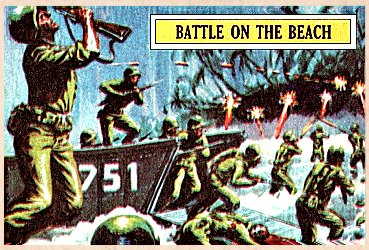 |
 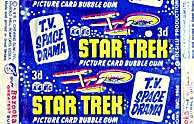 |
| Lyons
Maid |
Mister Softee Ltd. | Tonibell Manufacturing Co Ltd. | Neilson Holdings | Wall's Ice Cream |
|
1962: Train Spotters
(50), Birds & Their Eggs (25) 1963: Space Exploration (40) 1964: Famous Locomotives (40), 100 Years of Motoring (50) 1965: Famous Aircraft (40) 1966: Famous Cars (40), Famous People (48) 1967: Views of London (40) 1968: Space Age Britain (40), All Systems Go (40) 1969: European Adventure (40), Into the Unknown (40) 1970: British Wildlife (40), On Safari (40), Pop Stars (40) Most of these were with their 'Zoom' ice lolly but also produced a set of 40 Soccer Stars in 1970 for their 'Score' ice lolly. |
1961:
Did You Know? (25) 1962: Moon Mission (15), TV Personalities (25) 1963: Top Twenty (20), Your World (12) 1964 :Top 10 (issued with Record Mirror) (12) 1965: Top 10 (address N7) (12), 1966: Top Ten (address W6) (12) Star Cards (numbered with address) (12) 1967: Star Cards (numbered no address) (12) 1968: Star Cards (unnumbered) (24) 1969: Pop Parade (24) |
All
1963: Did You Know? (25) Inventions that Changed the World (25) The World’s Passenger Liners (25) This Changing World (with line) (25) This Changing World (without line) (25) Wonders of the Heavens (25) |
1967:
Star Cards (numbered) (12 1968: Star Cards (issued with Disc & Music Echo) (24) 1970: Star Discs (24), Lord Neilson Identipic (15) 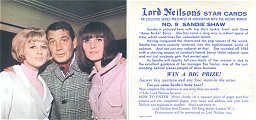 |
1965:
Do You Know (24) 1966: Moon Fleet (T.Wall & Sons) (48) 1967: Doctor Who Adventure (Sky Ray) (36) 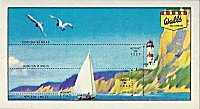
|
   |
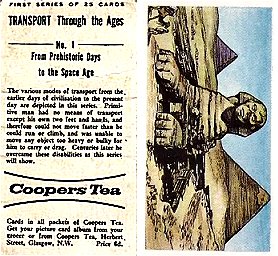 |
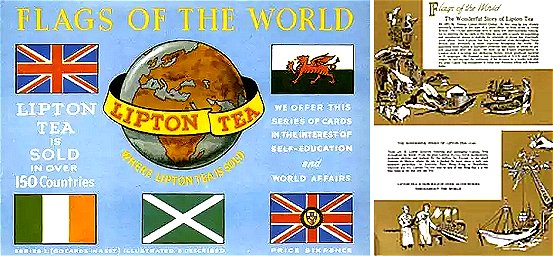 |
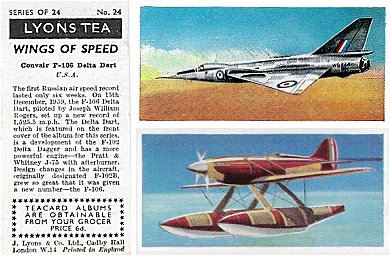 |
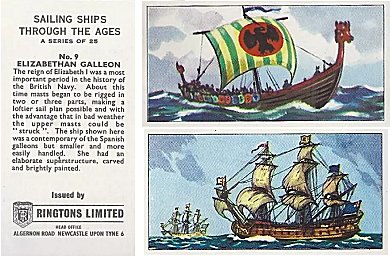 |
|
Coopers
Tea 1961
Strange But True (25) |
Liptons
Tea 1966
Flags of the World (60) |
Lyons
Tea 1961
Wings of Speed (24) |
Ringtons
Tea 1964
Sailing Ships Through the Ages (25) |
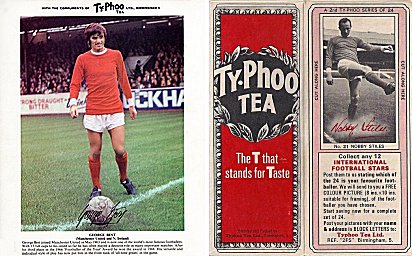 |
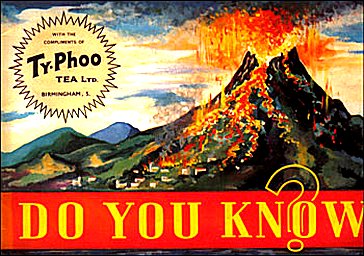 |
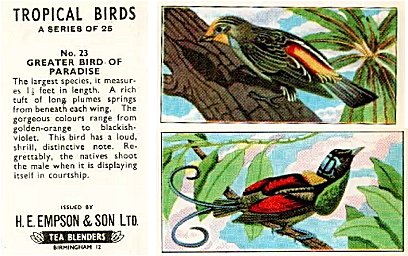 |
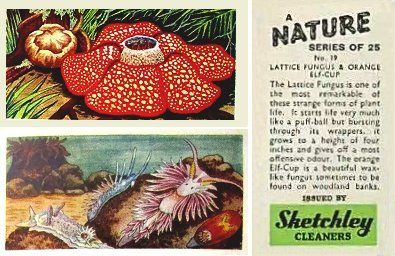 |
|
Ty-Phoo
Tea 1967
International Football Stars (24) |
Ty-Phoo
Tea 1962
Do You Know? (24) |
H.E.
Empson Tea 1966
Tropical Birds (25) |
Sketchley
Cleaners 1960
A Nature Series (25) (also issued by Sweetule Products in 1958) |
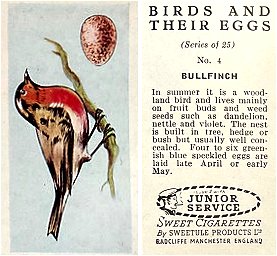 |
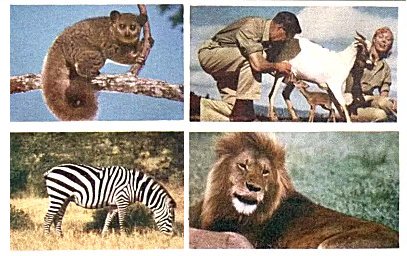 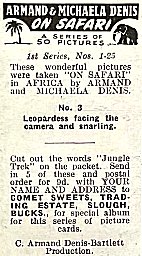 |
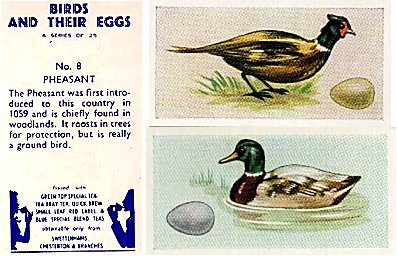 |
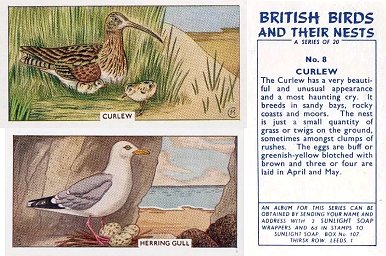 |
|
Sweetule
Sweets 1959
Birds and Their Eggs (25) |
Comet
Sweets 1961
Armand & Michaela Denis On Safari series 1 and 2 (25 cards in each) |
Swettenhams
Sweets 1958
Birds and Their Eggs (25) |
Lever
Brothers 1961
British Birds and Their Nests (20) (with Sunlight Soap) |
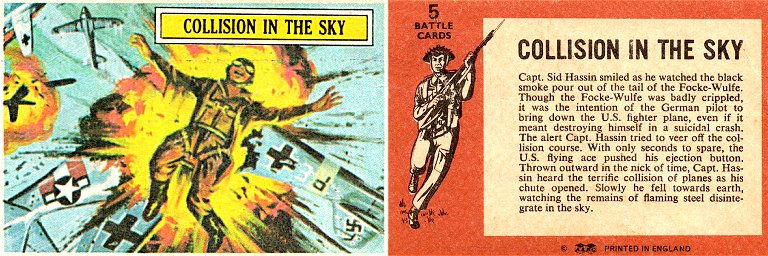 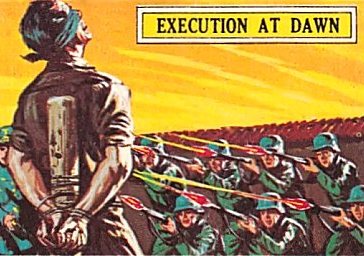 |
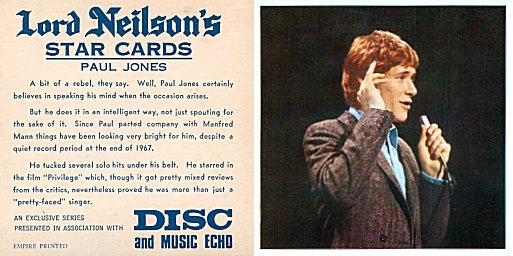 |
|
A&BC
1965 Battle Cards (73)
|
Neilson
1968 Star Cards (24) (in Disc and Music Echo)
|
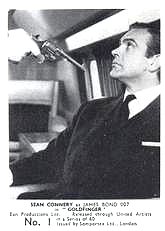 |
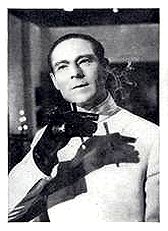 |
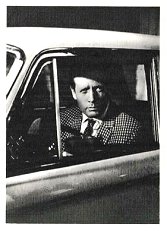 |
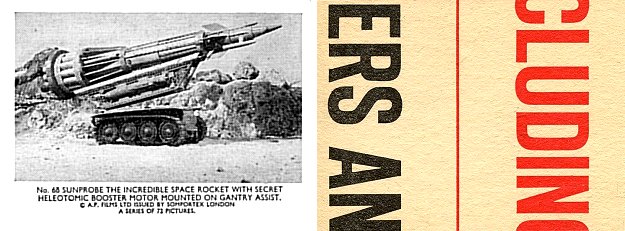 |
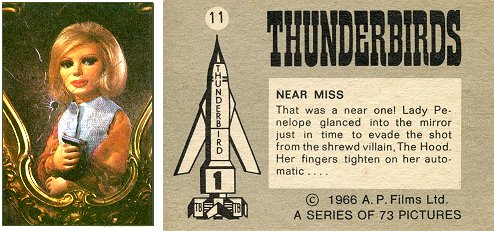 |
|
Somportex
1964
James Bond 007 (60) (Dr. No, From Russia With Love, Goldfinger) |
Somportex
1965
The Exciting World of James Bond (50) (Dr. No, From Russia With Love, Goldfinger) |
Somportex
1965
John Drake Danger Man (72) |
Somportex
1966
Thunderbirds (72) (black and white) |
Somportex
1966
Thunderbirds (73) (colour) |
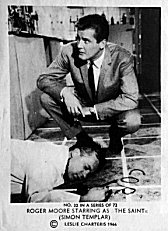 |
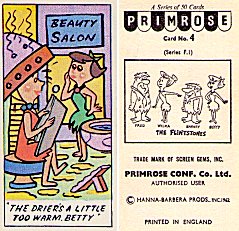 |
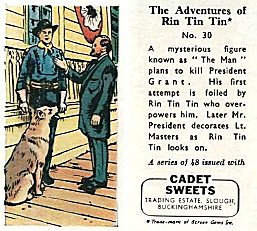 |
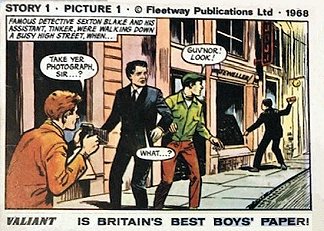
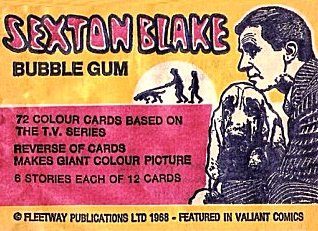
|
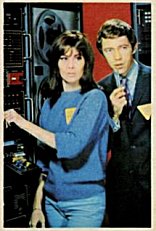 |
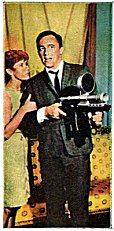 |
|
Somportex
1966
The Saint (72) |
Primrose
Conf. Co. Ltd. 1962
The Flintstones (50) |
Cadet
Sweets 1960
The Adventures of Rin Tin Tin (48) |
Somportex
1968
Sexton Blake (72) |
A&BC
1966
The Girl from UNCLE (25) |
Cadet
Sweets 1966
The Man from UNCLE (50) |
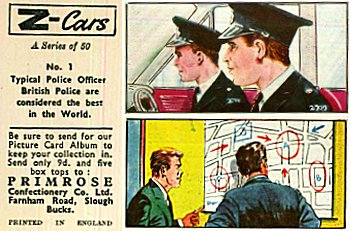 |
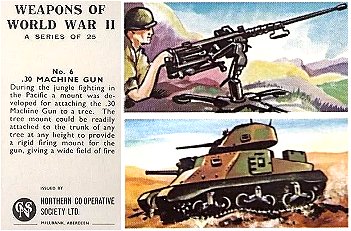 |
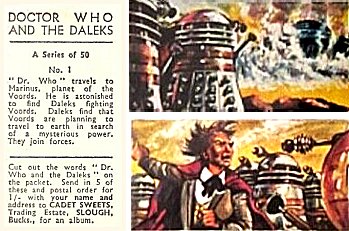 |
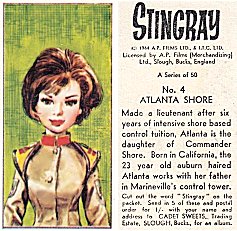 |
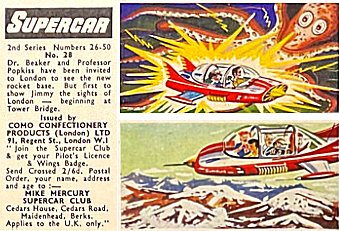 |
|
Primrose
Conf. Co. Ltd. 1968
Z Cars (50) |
Northern
Co-Op 1962
Weapons of World War II (25) |
Cadet
Sweets 1964
Dr. Who and the Daleks (50) |
Cadet
Sweets 1964
Stingray (50) |
Como
Confectionery 1964
Supercar Series 1 and 2 (25 cards in each) |
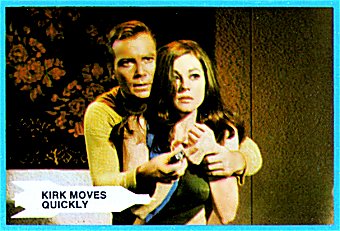 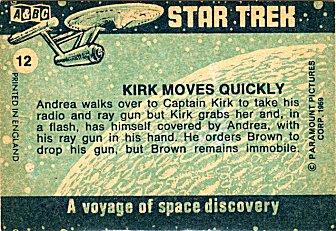 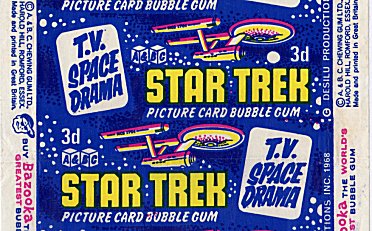 |
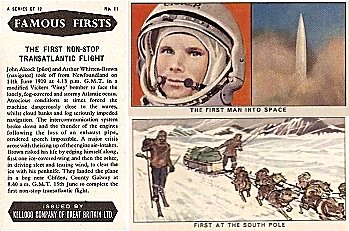 |
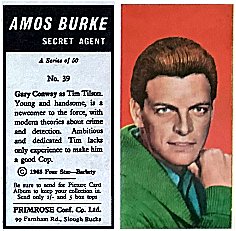 |
|
A&BC
1969
Star Trek (55) (all scenes are from the episode 'What Are Little Girls Made Of') |
Kelloggs
1963
Famous Firsts (12) |
Primrose
Conf. Co. Ltd. 1965
Amos Burke - Secret Agent (50) |
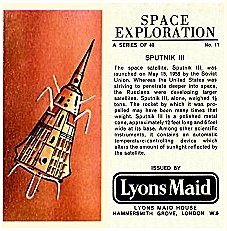 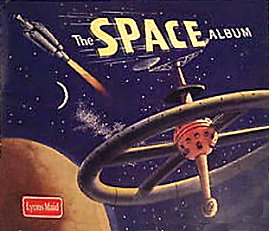 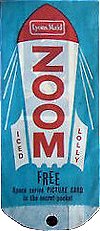 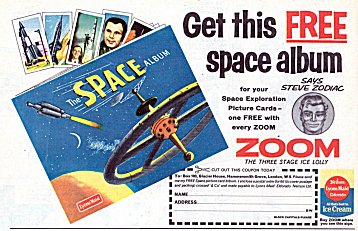 |
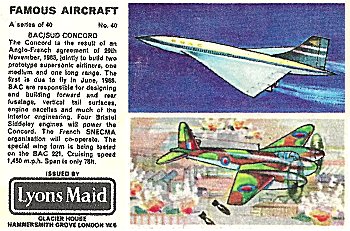 |
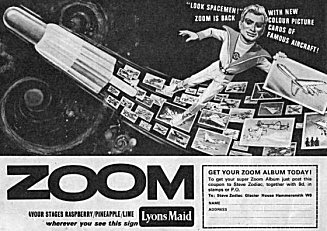 |
|
Lyons
Maid 1963
The Space Album cover
'Zoom' lolly
wrapper and The Space Album advert
Space Exploration (40) |
Lyons
Maid 1965
Famous Aircraft (40) |
Lyons
Maid 1965
Famous Aircraft album advert |
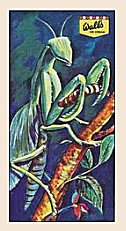 |
 |
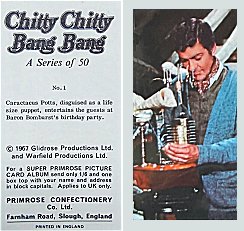 |
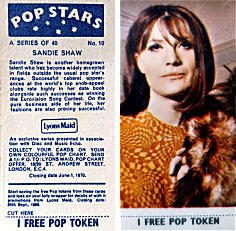 |
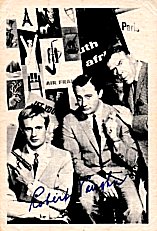 |
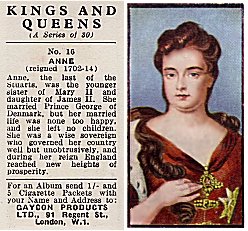 |
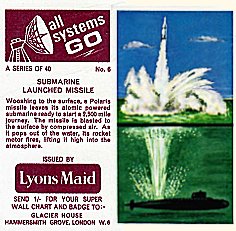 |
|
Wall's
Ice Cream 1965
Do You Know (24) |
Wall's
Ice Cream 1966
Dr. Who Adventure (36) |
Primrose
Conf. Co. Ltd. 1969
Chitty Chitty Bang Bang (50) |
Lyons
Maid 1969
Pop Stars (40) (in Disc and Music Echo) |
A&BC
1965
The Man from UNCLE (55) |
Gaycon
1961
Kings And Queens (30) |
Lyons
Maid 1967
All Systems Go (40) |
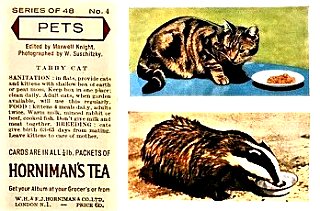 |
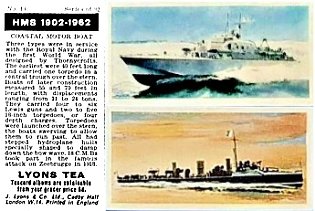 |
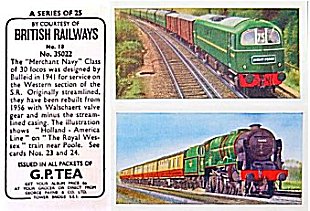 |
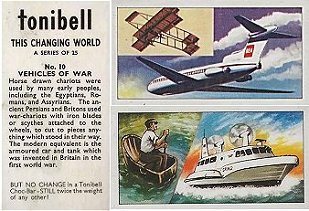 |
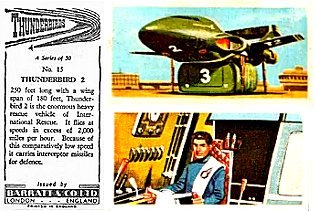 |
|
Horniman
(WH & FJ) & Co Ltd. 1960
Pets (48) |
Lyons
Tea 1962
HMS 1902-1962 (32) (descriptive back) |
G.P.(George
Payne) Tea 1962
British Railways (25) |
Tonibell
Manufacturing Co Ltd. 1963
This Changing World (25) |
Barratt
& Co. 1966
Thunderbirds (50) |
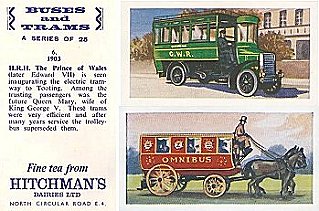 |
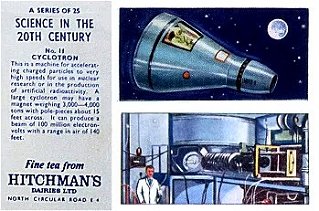 |
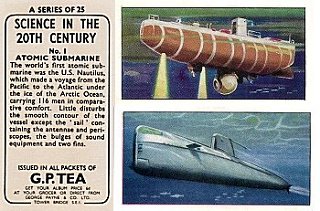 |
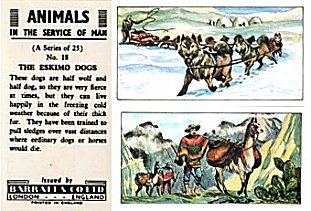 |
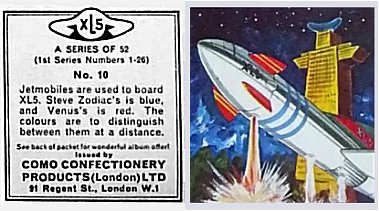 |
|
Hitchman's
Dairies (Tea) 1966
Buses and Trams (25) |
Hitchman's
Dairies (Tea) 1966
Science in the 20th Century (25) (same as GPT set) |
G.P.(George
Payne) Tea 1963
Science in the 20th Century (25) (same as set to left) |
Barratt
& Co.1964
Animals in the Service of Man (25) |
Como
Confectionery 1965
Fireball XL5 (52) |
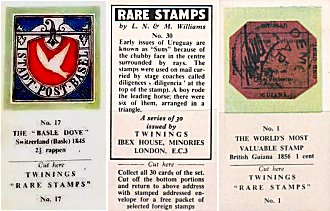 |
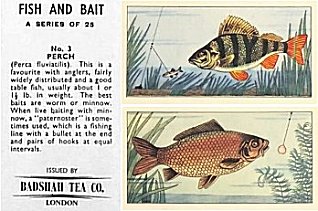 |
 |
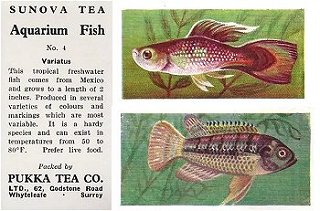 |
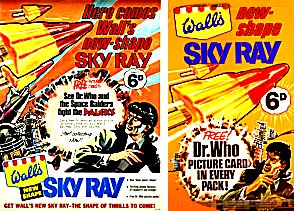 |
|
Twinings
1960
Rare Stamps (30) |
Badshah
Tea 1965
Fish and Bait (25) (set also issued by Barratt in 1962) |
Barratt
& Co. 1963
World Locomotives (25) |
Pukka
Tea (Sunova) 1961
Aquarium Fish (50) |
Wall's
1967
Sky Ray lolly advert |
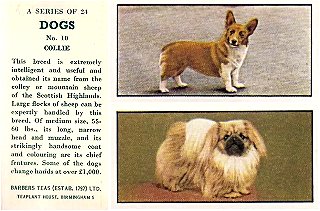 |
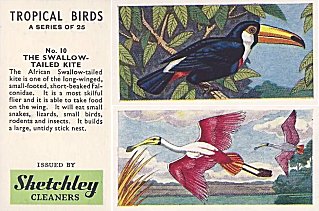 |
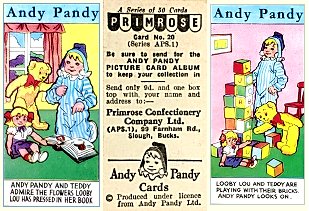 |
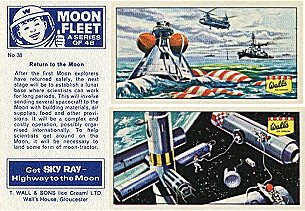 |
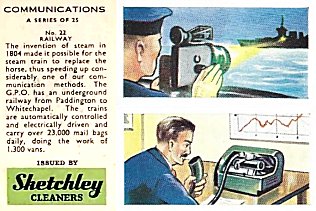 |
|
Barber's
Teas 1961
Dogs (24) |
Sketchley
Cleaners 1960
Tropical Birds (25) |
Primrose
Conf. Co. Ltd. 1960
Andy Pandy Cards (50) |
Wall's
Ice Cream 1967
Moonfleet (48) |
Sketchley
Cleaners 1960
Communications (25) |
|
|
All
Original Material Copyright SixtiesCity
Other individual owner copyrights may apply to Photographic Images |